 (Photo Courtesy: Pratik Shah)
(Photo Courtesy: Pratik Shah)The VIP tribe of this country is a self-serving, smug one. If you live in Chennai and happen to drop in at 'Coffee' near the Music college, look for this PWD order painted on the wall.
All the 5 W's, 1 H and a BIG O-pinion.
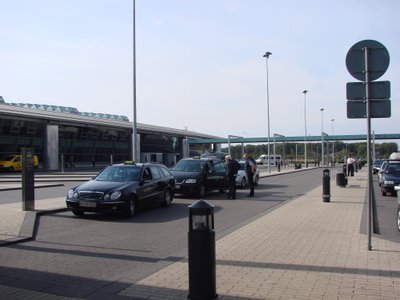
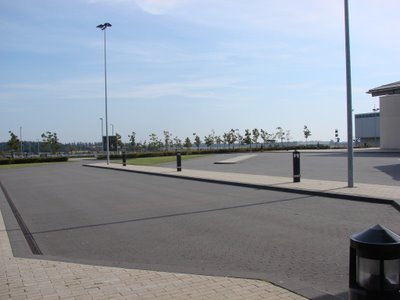
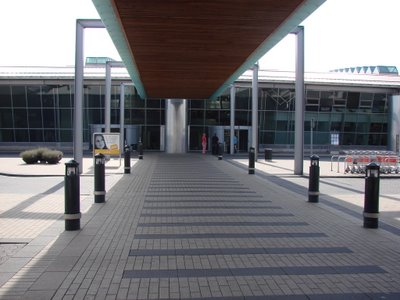
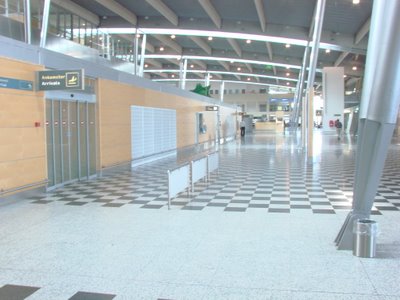

Today of course things are calm but Danish parents will still not send their kids to German schools or German parents to Danish schools for that matter, and, the older generation would still frown upon a German-Danish marriage.
There is a large Danish minority in the north German town of Flensburg where Danes like to drive down to do their shopping. People pay such high taxes in Denmark that its cheaper for them to drive down to Germany and do some monthly shopping there. Especially if they’re buying the famous Flensburger Pilsener also called Flens.
Back to Skamlingsbanken – and the great fluttering red flag next to the obelisk. Denmark’s national flag called the Dannebrog (old Danish for “The Danish cloth”) is red with a white cross that is not exactly in the center but a little to the left.
Its one of the oldest flags in the world. Legend has it, that during the Battle of Lyndanisse, in present day Estonia, it descended from the heavens at a crucial juncture, resulting in a Danish victory and given the Danish reverence for their flag, it goes without saying that the flag should flutter proudly next to the restored obelisk.

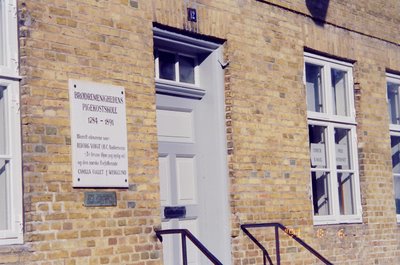
 The Moravian graveyard is known as “Gods Acre” or “church of the dead” with the sisters buried to the right and the brothers to the left. All the gravestones are exactly the same as a symbol of all being equal and alike after death. Here the graves have been preserved since 1773. Interestingly, a Moravian funeral will not involve the telling of stories about the deceased by relatives and friends. Instead, as Moravians age, they start to document the story of their lives on their own and they remain a rich treasure for posterity.
The Moravian graveyard is known as “Gods Acre” or “church of the dead” with the sisters buried to the right and the brothers to the left. All the gravestones are exactly the same as a symbol of all being equal and alike after death. Here the graves have been preserved since 1773. Interestingly, a Moravian funeral will not involve the telling of stories about the deceased by relatives and friends. Instead, as Moravians age, they start to document the story of their lives on their own and they remain a rich treasure for posterity.
 There were nearly 30 foreigners working at the Danish Crown plant in Grindsted. Many from Vietnam and a few from Sri Lanka – like Kandiah Kankanidhi (in picture). Kandiah is from Achchiveli in Jaffna and he fled the war in Sri Lanka in 1985. He landed in Tamil Nadu and lived in Purusuwalkam briefly before seeking asylum in Denmark. He lives in Grindsted with his wife and two boys aged 4 and 10. He still has two brothers back in Achchiveli and is able to send a considerable sum of money back home. He was making nearly 170 Kr. per hour, which is around 1360 Indian rupees. (People work 35 hours a week in Denmark.)
There were nearly 30 foreigners working at the Danish Crown plant in Grindsted. Many from Vietnam and a few from Sri Lanka – like Kandiah Kankanidhi (in picture). Kandiah is from Achchiveli in Jaffna and he fled the war in Sri Lanka in 1985. He landed in Tamil Nadu and lived in Purusuwalkam briefly before seeking asylum in Denmark. He lives in Grindsted with his wife and two boys aged 4 and 10. He still has two brothers back in Achchiveli and is able to send a considerable sum of money back home. He was making nearly 170 Kr. per hour, which is around 1360 Indian rupees. (People work 35 hours a week in Denmark.)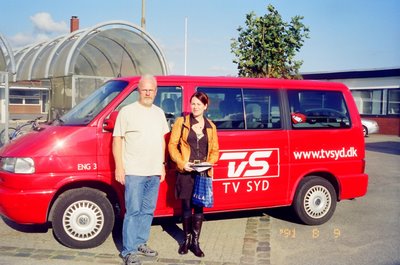 TV Syd serves the southern region of Denmark – called South Jutland. I spent a day at their office observing how they work and that’s how the pig story happened. I was assigned to go with the team of Dorte Vinther (both in picture) and cameraman, Arne Andreasen. Dorte had yawned during the morning meeting and was thereafter referred to as “the sleepy reporter.”
TV Syd serves the southern region of Denmark – called South Jutland. I spent a day at their office observing how they work and that’s how the pig story happened. I was assigned to go with the team of Dorte Vinther (both in picture) and cameraman, Arne Andreasen. Dorte had yawned during the morning meeting and was thereafter referred to as “the sleepy reporter.” Once there, we had to wear space suits like these before going into the factory where Arne and Dorthe got down to business while I got down to staring.
Once there, we had to wear space suits like these before going into the factory where Arne and Dorthe got down to business while I got down to staring.
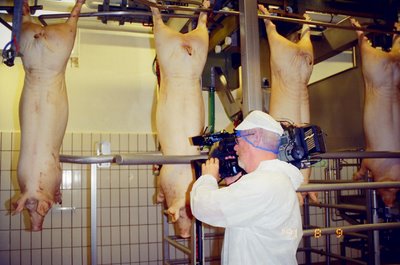

 Arne shot for about 30 minutes and then Dorte began her interviews. The story about the imminent closure of this plant had been done before so she did a soft story on what people were feeling on the day it actually happened.
Arne shot for about 30 minutes and then Dorte began her interviews. The story about the imminent closure of this plant had been done before so she did a soft story on what people were feeling on the day it actually happened.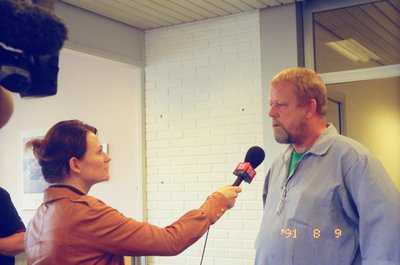 The union leader, Kent Kaltoft was interviewed outside the plant. He said, "Of the 700 workers, 500 already have a job. But I'm not going to stop till the last person finds a job."
The union leader, Kent Kaltoft was interviewed outside the plant. He said, "Of the 700 workers, 500 already have a job. But I'm not going to stop till the last person finds a job."
 Here in India we keep our equipment in the office. But at TV Syd, all the equipment remains in the ENG (electronic news gathering) van. It’s equipped with chargers and monitors and everything else required in handling a breaking news story. Just jump into this thing and hit the spot. Here, Arne puts everything back in place.
Here in India we keep our equipment in the office. But at TV Syd, all the equipment remains in the ENG (electronic news gathering) van. It’s equipped with chargers and monitors and everything else required in handling a breaking news story. Just jump into this thing and hit the spot. Here, Arne puts everything back in place.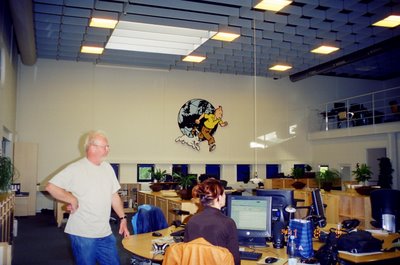 Back in the office Dorte begins to write her story in the newsroom. The picture of Tintin looks down upon the place. Why is it there? Because according to the news head Ernst Moller, “hes the best reporter in the world!” That is true.
Back in the office Dorte begins to write her story in the newsroom. The picture of Tintin looks down upon the place. Why is it there? Because according to the news head Ernst Moller, “hes the best reporter in the world!” That is true. Once the script is done, the edit begins.
Once the script is done, the edit begins.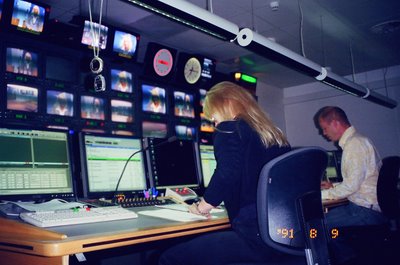
 These are pictures of the production control room. Everything that happens in the studio is controlled from here. The plant's closure became the top story that evening.
These are pictures of the production control room. Everything that happens in the studio is controlled from here. The plant's closure became the top story that evening. These pictures were taken at the Danish Crown factory in Grindsted, Denmark. The plant was shutting down because it was too small and it was no longer viable to run it. The pigs are gassed in a chamber just ahead of this one. Here they enter the assembly line where man and machine go to work to remove the innards. This is how it ends up as bacon and ham at the breakfast table.
These pictures were taken at the Danish Crown factory in Grindsted, Denmark. The plant was shutting down because it was too small and it was no longer viable to run it. The pigs are gassed in a chamber just ahead of this one. Here they enter the assembly line where man and machine go to work to remove the innards. This is how it ends up as bacon and ham at the breakfast table.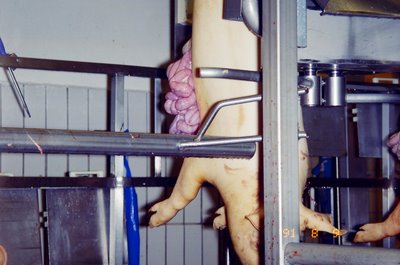
 There are quite a few stages and each worker or machine yanks out a specific part from inside the pig. Theres blood all over the floor and thats not the scary part. Instead, its the knives in the workers hands. I kept thinking, what if one of them went berserk one morning? (Like that morning.) But workers in Denmark are not frustrated. More on that later.
There are quite a few stages and each worker or machine yanks out a specific part from inside the pig. Theres blood all over the floor and thats not the scary part. Instead, its the knives in the workers hands. I kept thinking, what if one of them went berserk one morning? (Like that morning.) But workers in Denmark are not frustrated. More on that later.
 This is pretty much the last stage of the inside-clearing job. As you can see, theres almost nothing there!
This is pretty much the last stage of the inside-clearing job. As you can see, theres almost nothing there!
Now, the Danes love using their flag. Everyone has a flagpole in their lawn and if its someones birthday the flag goes up. Little flags even go into the birthday cake and all over stores in Denmark you will find all kinds of everyday things with the flags design, like, notebooks, pens, pencils, postcards and of course flags. So it was only appropriate that the last pig that came out of the assembly line went through proudly with the Danish flag in it.
It was an emotional day for the employees at Danish Crown in Grindsted. They had worked side by side for many years and as the last pig rolled out a wave of nostalgia swept over them. But everyone was still smiling. Unemployment is so low in Denmark (about 3%) that only a minority of the nearly 700 workers here had not yet found another job.



Company owners reportedly still have good relations with their buyers in the middle east but under pressure from local mullahs and imams, people there are unable to carry on business with the Danes.